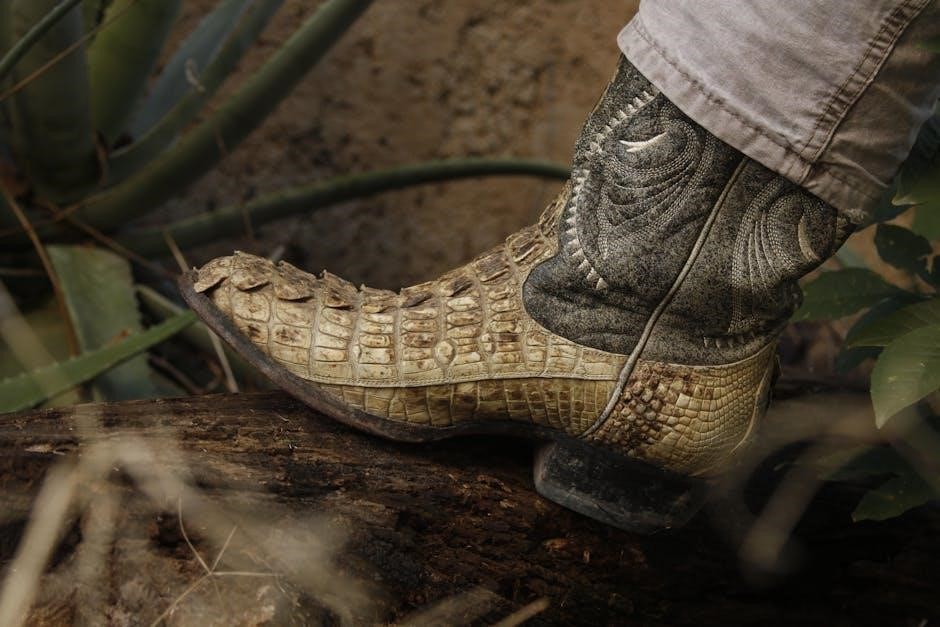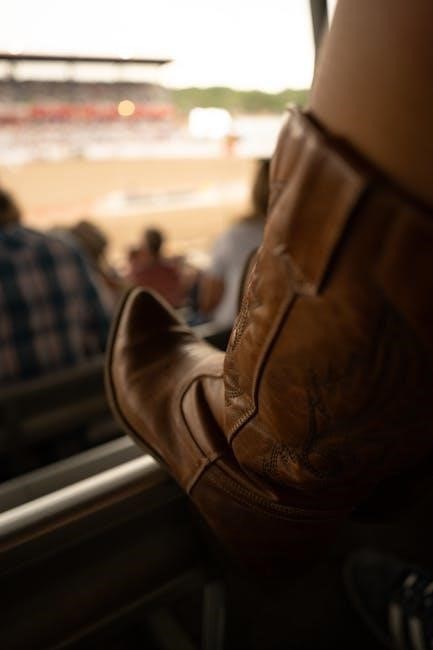Cowboy boots offer a unique blend of style and comfort, but their fit differs from standard shoes. Proper sizing ensures optimal support and a timeless look, making this guide essential for finding your perfect pair.
Understanding How Cowboy Boots Should Fit
Cowboy boots should fit snugly but not overly tight, with a slight heel lift (about 1/8th of an inch) for comfort. The instep should feel secure, like a firm handshake, while allowing adequate toe space—roughly the width of your thumb sideways. A proper fit ensures support and prevents discomfort or blisters. Unlike regular shoes, cowboy boots may feel tighter initially but will mold to your feet over time. The ball of the foot should align with the boot’s widest part, and the heel should stay in place without excessive slippage. Striking this balance is key to enjoying the comfort and style cowboy boots offer.
Why Proper Sizing Matters for Comfort and Style
Proper sizing is crucial for both comfort and style in cowboy boots. Ill-fitting boots can lead to discomfort, blisters, or even long-term foot issues, while the right fit enhances durability and aesthetic appeal. Boots that are too tight restrict movement, causing pain, while those too loose may slip excessively, leading to instability. Correct sizing ensures the boot supports the foot’s natural shape, providing stability and promoting all-day wearability. Additionally, proper fit maintains the boot’s structural integrity, preventing premature wear and tear. Achieving the right balance ensures cowboy boots remain a stylish and comfortable footwear choice for years to come.
Measuring Your Feet for the Perfect Fit
Accurate foot measurement is essential for a comfortable and stylish fit. Measure later in the day when feet are largest, ensuring proper sizing for cowboy boots.
How to Measure Foot Length and Width Accurately
To ensure a precise fit, measure your foot length by standing against a wall with your heel touching it. Use a ruler to mark the tip of your longest toe. For width, measure the widest part of your foot, typically across the ball. Use a flexible measuring tape or a Brannock device for accuracy. Stand while measuring, as feet expand slightly when bearing weight. Record both measurements and compare them to a size chart. This method ensures you account for foot shape and size variations, helping you select the most comfortable and stylish cowboy boots for your needs.
Why Foot Measurements Should Be Taken Later in the Day
Foot measurements should be taken later in the day because feet naturally swell due to activity and heat. This swelling can increase both length and width, ensuring the boots will fit comfortably throughout the day. Measuring in the morning may result in a smaller size, leading to tight boots by evening. To achieve the most accurate fit, measure your feet after a full day of activity. This ensures the boots will accommodate your feet at their largest, providing comfort and preventing blisters or discomfort. Proper timing guarantees a more reliable fit for your cowboy boots, making this step crucial in the sizing process.
Using Size Charts and Fit Guides
Size charts and fit guides are essential for selecting the right cowboy boot size, ensuring proper length, width, and international conversions for comfort and style across brands.
How to Compare Length, Width, and International Conversions
When comparing length, width, and international conversions for cowboy boots, start by measuring your foot accurately. Use a size chart to match your foot length and width to the boot’s specifications. Consider that different brands may have slight variations in sizing. International conversions can also vary, so refer to the brand’s specific chart to ensure accuracy. For example, a US size 10 may differ from a European or UK size. Pay attention to width options like narrow, medium, or wide to ensure comfort. Proper alignment of length, width, and international conversions guarantees a precise fit, blending comfort and style seamlessly.
Why Brand-Specific Sizing Variations Are Important
Brand-specific sizing variations are crucial because different manufacturers use unique lasts and materials, affecting fit. Some brands cater to specific foot shapes or preferences, such as wider toes or narrower heels. Additionally, leather stiffness and heel lift can vary, impacting comfort. While this may seem inconvenient, it allows for a more tailored fit. Always consult the brand’s size chart, as sizing can differ significantly between brands. For example, one brand’s size 10 might fit like another’s size 9.5. These variations ensure that you can find a boot that aligns perfectly with your foot shape and personal comfort needs, making the effort worthwhile.
Physical Try-On and Fit Tips
Physical try-ons ensure a precise fit, allowing you to assess comfort, support, and any necessary adjustments. This step is crucial for confirming the boot’s suitability for your foot shape.
Snug Fit Through the Arch and Proper Heel Lift
A snug fit through the arch ensures stability and support, while proper heel lift (about 1/8th of an inch) prevents excessive slippage. This balance guarantees comfort and prevents discomfort or blisters. A snug fit around the arch should feel firm but not restrictive, allowing natural movement. Proper heel lift ensures the boot stays secure without causing friction. If the heel slips too much, it may indicate a need for a smaller size. This combination of snugness and lift is key to a comfortable, functional fit that supports your foot during long wear.
Adequate Toe Space and Instep Comfort
Adequate toe space is crucial for comfort, ensuring your toes can move slightly without feeling cramped. Aim for about a sideways thumb width of space to prevent blisters and discomfort. The instep should fit snugly, like a firm handshake, providing support without pressure. If the instep feels too tight, it may lead to discomfort during wear. Proper toe space and instep comfort ensure your boots feel great all day, whether you’re walking or standing. A well-fitting boot balances these elements, offering both style and functionality for any occasion, from casual to formal events.
Final Tips for Sizing Your Cowboy Boots
Ensure a snug yet comfortable fit. Most men size down for proper fit. A slight heel lift is normal; excessive slippage may require sizing adjustments. Balance is key.
When to Size Down or Up for the Best Fit
Most men find they need to size down by one full size compared to their athletic shoes for the best fit. Cowboy boots should feel snug but not tight, with a slight heel lift (about 1/8 inch) for comfort. If you experience excessive heel slippage, consider sizing down. Conversely, if the boot feels too tight or pinches, sizing up may be necessary. For wider feet, opt for a wider width or size up slightly. Remember, cowboy boots will mold to your feet over time, so prioritize a comfortable yet supportive fit. Try boots later in the day for the most accurate sizing.

How to Break in Boots for Maximum Comfort
Breaking in cowboy boots requires patience and the right techniques. Start by wearing them with thick socks for short periods, gradually increasing wear time. Use leather conditioners to soften the material, ensuring a comfortable fit without compromising structure. For stubborn stiffness, try the freezer method: fill a ziplock bag with water, place it inside the boot, and let it freeze to stretch the leather naturally. Avoid extreme heat, as it can damage the leather. Proper break-in enhances comfort while maintaining the boot’s integrity. Remember, cowboy boots mold to your feet over time, so consistent wear is key to achieving the perfect fit.
Finding the perfect cowboy boot fit ensures comfort, support, and style. Proper sizing, accurate measurements, and trying boots on are crucial. With the right fit, cowboy boots become a reliable, long-lasting companion for any occasion.

Key Takeaways for Finding Your Perfect Cowboy Boot Fit
To ensure the best fit, measure your feet accurately, especially later in the day when they are largest. Use size charts to compare length and width, and consider brand-specific variations. A snug fit through the arch and proper heel lift (about 1/8 inch) are essential for comfort and support. Ensure adequate toe space, allowing about a sideways thumb width. If needed, size down for a tighter fit or up for more room. Breaking in boots gradually will enhance comfort. By following these guidelines, you can find a pair of cowboy boots that offers both style and long-lasting wear.




